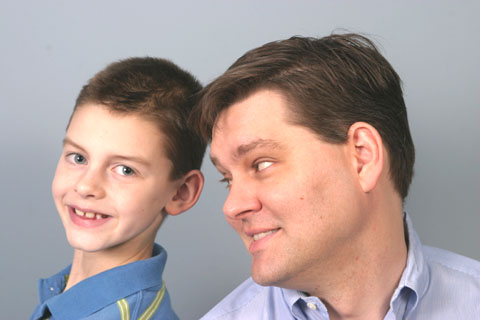Sign In
|
The Curtain Drops Slowly, With Hope  The Curtain Drops Slowly, With Hope As a 39-year-old diabetic, I thought I was young and invincible. Diabetes is the leading cause of new blindness in the United States.More specifically, a complication from the disease called "diabetic retinopathy" is the cause. Usually in my newspaper articles, I look at the fallacies of society and the quirks that make life fun. But this week, I have more or less been called to do what will be my first, and possible last, public service message. Over the last year or so, I've alluded to my failing eyesight in my column. Most of my friends know what I've been through, but I've been bombarded with e-mails and inquiries as to "what's the story." So, in the spirit of public service, and as a way of personal therapeutic confrontation, I present you with "the story." I've been a diabetic for almost 25 years. I found out, through the help of a health teacher at Lebanon High School, Dave Hedges, that I had Type I Diabetes Mellitus. (The real fun kind that comes with needles, insulin, and lots of blood-letting.) It was tough growing up with the disease, and I think I did a fairly decent job of monitoring my condition. But, as statistics show, even the best-controlled diabetes can lead to long-term complications such as heart disease, blindness, and neuropathy of the feet and hands. Being young and seemingly immortal, I rarely thought about those dark subjects. I figured that I would face them when "the time came," which I estimated would be in my 50s or 60s. I also hoped that before those complications set in, a cure would be found and I would receive a reprieve from any horrible side effects. And I'm not alone: In the United States, more than 20.8 million people, or 7 percent of the population, have diabetes. The World Health Organization calls it an epidemic. Flash forward to my 38th year on Earth. It was a bright sunny summer Sunday afternoon. I was upstairs in my bedroom, changing clothes from church. Since there was a wonderfully warm sun spot on the floor of the bedroom (that my cat had already curled up in) I laid down with a pillow to enjoy the breeze and sunshine. I woke up looking out the window, and knew something wasn't right. A large, dark squiggle was visible in my right eye. It was almost like a small bundle of dark threads. I tried to blink it away, tried some eye drops, and looked in the mirror, but nothing foreign seemed to be in my eye. After a few days of this dark spot, I contacted my eye doctor, who advised me to come in to his office "right now." That didn't sound good. The doctor gave me a vigorous battery of tests and announced, "You've got a pretty advanced case of retinopathy. There's some serious damage in both eyes." I was shocked, of course, since I was still young, or so I thought. The dark squiggles come when the fragile blood vessels that nourish the eye are damaged. The vessels bleed, break, and grow abnormally. The abnormal growth can cover the light sensing tissues on the retina, causing blind spots and eventually blindness. After a series of laser surgeries, which attempted to cauterize the vessels and prevent more abnormal growth, it became apparent that my condition was worsening. I couldn't drive at night, and my right eye became as blurry as if I had a smear of Vaseline over it. After weeks, then months, of treatments, my limited vision became wavy -- almost like I was looking in a Fun House mirror. The doctor told me that it was because my retina was detaching. I had a more invasive surgery, complete with doctors, nurses, and an esthesiologist. The surgery was wildly successful, although I looked like I'd gone 15 rounds with Muhammad Ali for several weeks afterward. My recovery has been slow, but there have been moments of great hope. The outpouring of love and care from my friends and family left me humbled -- no easy thing for such an outlandish, cocky extrovert as myself. But please hear this cautionary tale: If you are a Type I or Type II diabetic or have even border line symptoms, it is essential that you not only see your diabetes care specialist on a regular basis, but also make an appointment to see a ophthalmologist at least every six months. The earlier that any long-term complications are detected, the better the chance at recovery. I did follow all these steps (my insurance company hates me), yet I was still afflicted with retinopathy. Nothing is guaranteed, but again, early detection (much like cancer) seems to be the key. If you have concerns about your diabetes or becoming diabetic, contact your doctor. For more great and non-technical information on symptoms, treatment, and research, see the American Diabetes Association's excellent Website at www.diabetes.org. As for me, life has taken a bizarre turn that I never anticipated. But this next chapter in life has reinforced and taught me about what's really valuable in life: God, family, and friends. And, as my brother likes to quote, "Pain is only temporary." These lessons give me an ironically brighter view of life. As Johnny Nash sang, "Gone are the dark clouds that had me blind. It's gonna be a bright, bright sun shiny day." |


